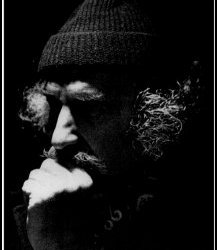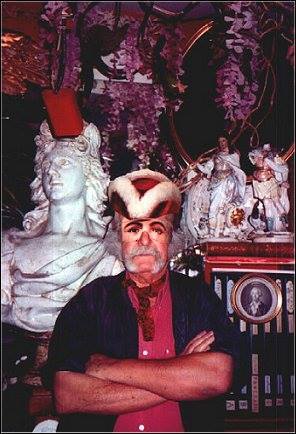#claude seignolles
Text
THYME AND ROSEMARY CROSS
''On the morning of Saint-Jean, the young girls of Roussillon place bouquets gathered the day before in the countryside on a cross at the doors and windows of their house, to prevent entry to the bad fairies.
This custom has a legendary origin: a young girl, in love with a handsome mountaineer whom she was to marry, put on her door, without thinking about it, two bouquets of thyme and rosemary forming a cross.
When her fiancé came, he dared not enter, pretending that the bouquet was in the shape of an asp.
- It is not an asp, replied the beauty, but a cross; bad people alone are afraid of the cross.
- Well! I'll admit it to you, I'm the Devil who came to get your soul and who would have achieved his ends without this cursed bouquet.''
Claudes Seignolles • Gospels of the Devil (the Devil in man)
#french folklore#folklore#france#folk magic#cross#protection#thyme#rosemary#the devil#the devils gospels#claude seignolles#magic#french magic#french folk magic#litha#saint-jean#june 21st#occult#roussillon#folklore du Roussillon#midsummer#solstice#summer solstice
26 notes
·
View notes
Text

7 notes
·
View notes
Text
Взгляните на это… 👀
Взгляните на это… 👀 https://pin.it/5yJn60T
5 notes
·
View notes
Text
Since I was asked about "wishes" in French fairytales, I was remembered of one "folk-fairytale" I came across recently... It is a French variation of "The Fisherman and his Wife", that was collected by Claude Seignolle as part of a quest for the fairytales of Guyenne (a former region of France that doesn't exist anymore but covered most of south-west France).
The story is called "The poor people that were too envious"
Once upon a time there were very poor and sad people who lived in a small cabin in the woods. They were three: a father, a mother and a son. One year, they were even poorer than usual - bread, which was already rare on their table, was completely gone, and all they could eat were the roots of ferns (which taste very bad). One day, the mother sent her son on the road, so he could beg for some bread - she hoped that people would take pity on a hungry child.
On the road he met an old woman who asked him what he was doing. He explained the situation and she told him: Go back to your house, you'll find half of a loaf of bread. And indeed when he returned he found half of a loaf of bread on the table - because his parents had sliced up the other half and were eating it. The child told them it was an old woman he met on the road that had sent the bread.
The following day, the mother wanted to make soup. She asked her son to go on the road, try to find the same old lady, and ask her for some lard to make the soup. The old woman told the boy to return home, he would find a piece of lard hanging from the chimney - and lo and behold, when he came back his mother was cutting little pieces of lard to make her soup!
The mother was getting curious and so she asked her son to go on the road again, but this time to ask who was the old woman, and how she could "grant all our desires". The little boy asked the old woman this, and she told him: "Young one, I am the fairy, I am your godmother". When the boy told this to his mother, she asked what this fairy actually looked like... And the boy described how her teeth were as long as fingers, her ears so big they were like those of a donkey, her eyes so large they were like those of a cow, and her white hair so long it dragged on the floor. The parents were very surprised by this description, but not afraid.
The following day, the mother sent her son again to ask for something to drink, and they had large pints of wine.
And so each day the mother sent her son asking for new things. She asked for a new house ; and then for new clothes ; and then for money ; and then for horses and a stable ; and then for a castle... And each time the fairy godmother gave what the little boy asked her.
But one day... One day the mother sent her boy to ask the fairy this: Make the father a king, make the mother a queen, make the son a prince. He asked his fairy godmother this and all she replied was: "Go back home, and you'll see." And when he returned to his castle, the boy discovered that his parents had been turned into a couple of owls.
And then he looked at his own body... and found he was now a toad.
The end
#french fairytales#the fisherman and his wife#well a variation#fairy godmother#guyenne fairytales#folkloric fairytale
8 notes
·
View notes
Note
You mentioned the Évangiles du Diable as containing racism and antisemitism, I looked it up and saw that Claude Seignolle wrote it. I have a different, non-devil-centric folklore book by him, should I beware of false information or bias on his part? Or would you say it's just folkloric tales in general to be careful about? Glad I saw your post!
Hello ! It's not about false information it's more about him just giving us the old tales without really filtering it. That's why in that other post I said you should look at how the people from that place viewed strangers and people from other spiritual belief (but most of the time the caricature are based on black and Jewish people) because a lot of books about folklore just give us the stories without explaining anything, so it's not misinformation it's more that you need to see which story is about the devil and which one is about actual people
Fr the caricature are so grotesque even without research I understood when it was the case in the évangile du diable because most stories describe what ""the devil"" looked like. So yeah that's the big deal with folkloric book Authors don't often explain their stories or give very few information and they rarely focus on the racism who was present back in time so that's our job to inform ourselves on that subject.
So yup it's a problem around folklore in general, old stories told by old people with old mindset
4 notes
·
View notes
Photo

The Accursed, by Claude Seignolle (Tandem, 1971).
From eBay
9 notes
·
View notes
Text
I'm at a point where there is a podcast on Claude Seignolle that I don't dare to listen, cause...
Claude Seignolle, the King !
One of the greatest ethnographers of our time. And unrecognized! (how lucky he is aha) (he played well...)
All his novels were directly inspired by stories that old people in remote villages had told him. And when you read the novels in question you tell yourself that there is something to worry about, #deliciously vibes. 🔥😍

(pic from Wikipedia)
1 note
·
View note
Text
Review: Alexandre Dumas' Le Meneur de Loups
This book (not to be confused with Claude Seignolle’s short story by the same title, linked below this review) was one of those cautionary tales, albeit with several excellent come backs from the protagonist on behalf of the poor, which were absolutely correct, but with a moral, or theme if you will, that I generally dislike: basically, the story ends by telling everyone that each person,…

View On WordPress
0 notes
Link
0 notes
Text
𝕱𝖗𝖊𝖓𝖈𝖍 𝖑𝖔𝖛𝖊 𝖘𝖕𝖊𝖑𝖑𝖘: 𝖔𝖋 𝖉𝖊𝖜 𝖆𝖓𝖉 𝖇𝖑𝖔𝖔𝖉

''In Dauphiné, to make yourself loved, when you are a boy, the easiest way, at Villard-de-Lans, is to roll around naked in the dew of the night from April 30 to May 1.
For girls, all they have to do is make the person they want to love drink a few drops of their period blood in wine and coffee; the boy can no longer ''detach''.
Claude Seignolles • The Devils Gospels • popular sex magic
#love magic#beltane#blood magic#french witchcraft#love spells#french love spells#traditional spells#french traditional witchcraft#traditional witchcraft#french folk witchcraft#witchcraft#dew#menstrual blood#the devils gospels#les evangiles du diable#claude seignolles#folk magic#french folk magic
18 notes
·
View notes
Photo

On le croyait devenu immortel, fruit d’un pacte avec le diable en sabots, mais à 101 ans, le fabuleux Claude Seignolle s’est éteint. Triste jour.
5 notes
·
View notes
Text
Whistling the Devil
It is unwise and dangerous to whistle on the road at night. After a moment, a much stronger whistling echoes back at you, and this one is nothing less than the Devil's, answering your call.
[...]
If your soul isn't pure, never whistle when you get back home at night... The Devil starts walking behind you and you can never make him leave.
Les Évangiles du Diable, Claude Seignolle, my translation
63 notes
·
View notes


